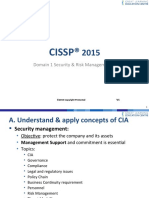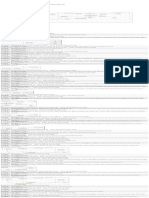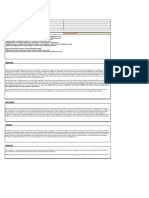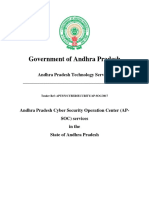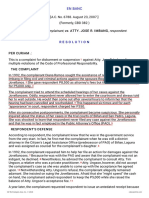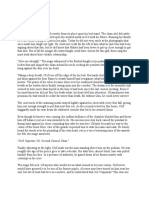Secure SDLC Framework - Final
Secure SDLC Framework - Final
Uploaded by
SyedCopyright:
Available Formats
Secure SDLC Framework - Final
Secure SDLC Framework - Final
Uploaded by
SyedOriginal Title
Copyright
Available Formats
Share this document
Did you find this document useful?
Is this content inappropriate?
Copyright:
Available Formats
Secure SDLC Framework - Final
Secure SDLC Framework - Final
Uploaded by
SyedCopyright:
Available Formats
Information Security Department
Secure Solutions Delivery Life Cycle
Framework
Developed and written by
Information Security Assurance
Riyad Bank, Olaya Towers, Tower-B, 8th Floor
+966-11-204 6600 x 3838
Version 1.0
Last Updated 06 December 2017
Documented Information Classification level Internal Use Only
Documented Information Owner ISD – IS Assurance
Next Review Date December 2019
Status Final
© Copyright 2017 Riyad Bank. All rights reserved.
SECURE SDLC FRAMEWORK
Document created by
Shakeel Shaikh, AVP – Head of Information Security Assurance
Document reviewed by
Aiedh Al-Zahrani, EVP – Head of Business Technology Division
Hosain Al-Malky, SVP – Mgr., Solutions Development & Delivery Dept.
Husam Al-Suliman, SVP – Head of Information Security Department
Hasan Abdullah Al-Amri, SVP – Acting Manager of BT Infrastructure Dept.
Rashed Al-Sheban, VP – Head of BT Change Mgmt. Section
Mohammed A Aziz, AVP - Head of Security Governance and Risk
Rabea J Al-Muzin, AVP – Acting Manager of PMO
Nouf F Bin Tamran, Acting Head of UAT Section
INTERNAL USE ONLY 1
SECURE SDLC FRAMEWORK
Contents
1. Introduction 3
2. Purpose of the Framework 3
3. Scope 3
4. References 3
5. Assumptions & Constraints 4
6. Roles and responsibilities 5
7. Secure SDLC Process 7
8. Concept 8
9. Acquisition 10
10. Planning 13
11. Design 14
12. Development 16
13. Build 17
14. Testing 20
15. Implementation and Post Implementation 22
16. Operations and Maintenance 23
17. Disposal 24
18. Executive Owner 24
19. Document Custodian 24
INTERNAL USE ONLY 2
SECURE SDLC FRAMEWORK
1. INTRODUCTION
Riyad Bank is continuously expanding the use of Information Systems to enhance and
expand the services offered to customers, and to optimize the internal business processes.
Introduction of every new system expose the Bank to various security risks. Information
Security risks have to be assessed and mitigated before any system can be used to support
the Bank’s business.
Riyad Bank has established a Solutions Delivery Life Cycle (‘SDLC’) framework for the
acquisition of new systems. Information Security should be addressed in all the stages of
the Bank’s SDLC to effectively address Information Security risks of new systems.
Information Security processes portrayed in this document should be catered in all project
management methodologies and change management processes.
Information Security should be involved at the earliest stage and subsequently in all stages
of the SDLC. The benefits of early and continuous involvement of Information Security
includes:
- It is less expensive to implement security controls in the early stages of projects
and changes.
- Security risks can be discovered in the early stage.
- It helps in delivering solution within the time to market requirements.
- Better security controls can be designed by participating in all stages of SDLC.
- Information Security becomes enabler in the solutions delivery process.
2. PURPOSE OF THE FRAMEWORK
The objectives of the Secure SDLC framework is to depict the involvement of Information
Security in SDLC processes, as outlines below:
- Document interaction of Information Security processes with SDLC processes.
- Provide an overview of activities performed by ISD while participating in projects.
- Describe the activities expected from related parties.
- Document the roles and responsibilities of all related stakeholders.
- Cover all project methodologies from security point of view.
3. SCOPE
The scope of this framework includes all technology-oriented projects in the Bank that are
registered with the Project Management Office. Technology-oriented projects following any
project management methodology will be within the scope of this framework.
4. REFERENCES
• ISP Policy
• Access Management Policy and Framework
• Encryption Policy
• Information Security Classification Policy
• System Development, Acquisition and Maintenance Security Policy
INTERNAL USE ONLY 3
SECURE SDLC FRAMEWORK
• Application security Requirement Standard
• Secure Code Security Guideline
• System Secure Engineering Standard
• Risk Assessment Process
• ISRA Methodology
• Penetration Testing Methodology
• Change Management Policy
• PCI and ISO Standards
• NIST 800-64
5. ASSUMPTIONS & CONSTRAINTS
This framework document and the processes described herein are based on the Solution
Delivery Life Cycle (SDLC) document, Version 2.22, dated 1st April 2009.
All implementations of technology projects in the Bank follow the above stated SDLC
methodology.
Secure SDLC Framework will operate independent of the Bank’s SDLC; while there will be
close interaction and integration with it.
BTD and BTG will modify their applicable processes to adhere to SDLC and Secure SDLC.
Bank’s SDLC and appropriate processes will incorporate the requirements of this
framework.
ISD will follow risk based approach in performing, not-performing, or expanding the scope
of tasks within the ISD responsibilities.
A new phase called ‘Planning’ has been added in the Secure SDLC, although it does not
exist in the Bank SDLC. Project Manager may execute this phase in the initial stages of
the project, as suitable. In this document, it is assumed that the planning phase will be
executed after the acquisition phase.
A new phase called ‘Development’ has been added in the Secure SDLC, although it does
not exist in the Bank SDLC. This phase is exclusively meant for software development.
This phase is not applicable to the projects wherein off-the-shelf systems are purchased
from the vendors (wherein source code is not created or is not held with the Bank).
While all actions shown in this document are shown as manual activities, some of them are
either automated or could be automated. Even though the activities are automated, the
responsible team will be accountable for the respective activity, in case automated
functions could not be performed by the respective system.
All relevant stakeholders will produce documents that are required to fulfill the
requirements in the SDLC and the Secure SDLC.
INTERNAL USE ONLY 4
SECURE SDLC FRAMEWORK
6. ROLES AND RESPONSIBILITIES
Roles and responsibilities of ISD:
Building of Operations,
Implementation &
Infrastructure and Testing (SIT & UAT) Maintenance &
Concept Acquisition Planning Design Development Post Implementation
Disposal
Application
ISD Representative Provide security Provide security Security Post Information
Maintain Security
in Steering requirements for architecture and Integration Testing implementation Security policies
Architecture
Committee BRD design review plan (ArcSight, cyber security and standards
Diagrams and PCI
Guardium, controls
Data-flows
Tripwire, LDAP, verification
ISD Representative Provide security Provide security etc.) (SIT) Security
(Includes ISRA
in Project Review requirements in integration testing Configuration
Ensure compliance control validation)
Team RFP plan Baselines
with Security Cyber Security
Architecture Controls testing
Evaluate proposals (UAT) Penetration testing
IS Risk Assessment Provide security (Internal\External Security event
(as applicable in from CIS acceptance testing as applicable) monitoring
case of SAMA perspective plan Penetration testing
requirement) (Internal\External
Provide post as applicable)
Ensure security
implementation (UAT)
requirements in
security activities
Scope of Work
plan
Maintain Security
Architecture
Diagrams and PCI
Threat Profiling Data-flows
IS Risk Assessment
INTERNAL USE ONLY 5
SECURE SDLC FRAMEWORK
Roles and responsibilities of Non-ISD:
System
Building of Operations,
Integration and Implementation &
Infrastructure and Maintenance &
Concept Acquisition Planning Design Development User Acceptance Post Implementation
Disposal
Application Testing
PMO: Request ISD BA: Notify ISD for PMO: Invite ISD to BTD: Adherence to
PMO: Create BTD: Scan source BTD: Install OS\ CMD: Notify ISD of
for Steering security provide the plans SIT: Notify ISD of the Information
security design code for security Database \ release to
Committee requirements of security SIT initiation Security Policies
document vulnerabilities Application and production
representative activities and Standards
BA: Incorporate configure as per
PMO: Request ISD security BTD: Fix all the baseline
PMO: Incorporate UAT: Notify ISD of
for Project Review requirements in vulnerabilities and UAT initiation BTD: Fix security BTD: Notification of
plans of security
Team BRS\BRD ensure clean issues Change Requests
activities in Master
representative source code scan BTD: Apply security
Project Plan
PMO: Notify ISD for report patches
BTD: Apply security BTD: Notification
RFP review BTD: Notify ISD
configuration (as from relevant team
BTD: Retain clean applicable) upon production
BTD: Perform VM about the disposal
PMO: Incorporate scan report deployment
scan and baseline of production data
security
scans and retain used in UAT
requirements in RFP BTD: Maintain
BTD: Inform ISD clean reports
System Security
PMO: Invite ISD to about clean source
Design BTD: Notification of
evaluate proposals code scan
BTD: Install and disposal of systems
configure security
PMO: Notify ISD tools (ArcSight,
upon Business Case Guardium,
approval Tripwire, etc.)
PMO: Notify ISD for
Scope of Work BTD: Inform ISD
review about completed
hardening process
PMO: Incorporate
security
requirements in
SoW
INTERNAL USE ONLY 6
SECURE SDLC FRAMEWORK
7. SECURE SDLC PROCESS
Secure SDLC maps to the Bank’s existing SDLC process. However, it has been made more
granular to address specific phases that are more relevant for Information Security.
Although Secure SDLC process applies to all Agile and Non-Agile projects, the Secure SDLC
process will be revised upon availability of Agile Project Management methodology of Riyad
Bank.
Secure SDLC processes applicable to Non-Agile projects have been divided into following
phases:
Implement
User ation & Operations,
Integration Maintenanc
Concept Acquisition Planning Design Development Build Testing Acceptan Post
e, &
ce Testing implement Disposal
ation
Participation and roles of all relevant stakeholders in various phases of Secure SDLC has
been described in the subsequent sections. Each stakeholder should incorporate associated
Secure SDLC requirements into all relevant processes.
Process flowcharts in this document have been illustrated from Secure SDLC perspective.
INTERNAL USE ONLY 7
SECURE SDLC FRAMEWORK
8. CONCEPT
During the concept phase, a steering committee and a technical review committee are
formed. Formation of the committees depends upon the type and complexity of the
project.
If a steering committee is being formed for a project, then Information Security shall be
invited to participate in the steering committee. If a technical review committee is being
formed for a project, then Information Security shall be invited to participate in the
technical review committee.
Following flow chart illustrates the process of Concept phase:
Project Sponsor
Dept.
Create PCD
Technology
Committee
Approval of PCD NO
YES
Concept Phase
Notify stake holders
Notify all
PMO
for Steering\Technical Form Steering Form Technical
Register Project stakeholders about
Committee Committee Review Committee
the committees
participation
ISD Management
Assign ISD
Assign ISD
representative in
representative in
Technical Review
Steering Committee
Committee
ISD Representative
IS Risk Assessment
Notify all ISD
(Applicable if SAMA
stakeholders about
approval is
the project
required)
Key definitions:
Project Sponsor Dept.: The department who benefits the most from the initiative and
who is responsible to get the PCD approved by technical committee.
Inputs to ISD:
- Notification from PMO about the new project, formation of Steering Committee, and
formation of Project Review Team.
- Project Concept Document
INTERNAL USE ONLY 8
SECURE SDLC FRAMEWORK
Outputs from ISD:
- Assignment of representative in Steering Committee.
- Assignment of representative in Project Review Team.
- IS Risk Assessment (Risk register - Applicable if SAMA approval is required.)
Artifacts necessary:
No artifacts are requires in this phase.
INTERNAL USE ONLY 9
SECURE SDLC FRAMEWORK
9. ACQUISITION
Discovery phase, Approval phase, and Acquisition phase from the Bank SDLC have been
combined into a single Acquisition phase in Secure SDLC.
Acquisition phase in Secure SDLC has been divided in three major activities:
Security requirements
Security participation in solution selection
Security review of Scope of Work
Security Requirements, which will be provided during the Requirements Gathering stage,
shall be only high level requirements to be addressed at an overall solution level.
Following flow charts illustrate the process of Acquisition phase. Each activity in the
Acquisition phase has been shown in a separate flow chart.
Security requirements:
Project Sponsor
Dept.
Business Analyst
Notify ISD for Incorporate security
security requirements in
requirements BRS\BRD
Acquisition Phase – Security requirements
PMO
ISD representative
Send and retain
Consolidate security
Inform ISD teams security Approve BRS\BRD
requirements
requirements
Security requirements
for the system
Security Analyst
Information
Assess security
related regulatory
requirements
applicable to the
system
Security Control
Requirements
Standard
Key definitions:
Business Analyst: The person responsible for documenting all the requirements.
Information Security Analyst: The person responsible to provide Information Security
requirements.
INTERNAL USE ONLY 10
SECURE SDLC FRAMEWORK
Inputs to ISD:
- Notification from Business Analyst (‘BA’) about collection of Business Requirements.
The notification can be automated through a system. BA will be accountable to
ensure that ISD representative receives such notification.
- Business Requirement Document
Outputs from ISD:
- Security requirements to be added into BRD (ISD will define some security
requirements as functional requirements.)
- Approval of Business Requirements Document.
Artifacts necessary:
- Security Control Requirements Standard.
Security participation in solution selection:
Project Sponsor
Dept.
Get the Business
Select solution
Case approved
Acquisition Phase – Security participation in solution selection
Issue RFP and Invite Notify all stake
PMO
Notify ISD for RFP Incorporate security Invite ISD to
proposals from holders about
review requirements in RFP evaluate proposals
vendors selected solution
Technical Review
Committee
Evaluate proposals
for technical
requirements
ISD representative
Share security Notify ISD
Submit evaluation
Inform ISD teams requirements to be stakeholders about
of proposals
added in RFP selected solution
ISD teams
Review RFP to Evaluate proposals
Provide security for compliance with
ensure security Create Threat
requirements\ security IS Risk Assessment
requirements are Profile
comments for RFP requirements
addressed
Security requirements Security requirements
for the system incorporated in RFP
Inputs to ISD:
- Notification from Project Manager about creation of RFP.
- Notification from Project Manager about evaluation of proposals.
- Request for Proposals.
- Technical Proposals.
INTERNAL USE ONLY 11
SECURE SDLC FRAMEWORK
- Notification upon approval of Business Case
Outputs from ISD:
- Security requirements to be incorporated in the RFP.
- Evaluation of the proposals.
Artifacts necessary:
- Security Control requirements for the system.
Security review of Scope of Work:
Project Sponsor
Dept.
Acquisition Phase – Security review of Scope of Work
Incorporate security
PMO
Notify ISD for Scope requirements in
of Work review SoW
Technical Review
Committee
ISD representative
Send security
Inform ISD teams requirements\
comments for SoW
ISD teams
Review SoW to
Provide security
ensure security
requirements\
requirements are
comments for SoW
addressed
Security requirements
incorporated in RFP
Inputs to ISD:
- Notification from Project Manager to review Scope of Works.
- Scope of Works.
Outputs from ISD:
- Security requirements to be incorporated in Scope of Works.
Artifacts necessary:
- Security Control requirements for the system.
INTERNAL USE ONLY 12
SECURE SDLC FRAMEWORK
10. PLANNING
Following flow chart illustrates the process of Planning phase:
Project Sponsor
Dept.
Invite ISD to provide Incorporate plans of
PMO
the plans of security security activities in
activities Master Project Plan
Technical Review
Committee
Planning
ISD representative
Consolidate security
Notify ISD teams to
plans & send them
provide their plans
to PMO
ISD teams
Provide post
Provide security Provide security Provide security
implementation
architecture and integration testing acceptance testing
security activities
design review plan plan plan
plan
Inputs to ISD:
- Notification from Project Manager to provide ISD plans
Outputs from ISD:
- Security architecture and design review plan
- Security integration testing plan
- Security acceptance testing plan
- Post implementation security activities plan
Artifacts necessary:
- Master plan of Information Security activities
INTERNAL USE ONLY 13
SECURE SDLC FRAMEWORK
11. DESIGN
Following flow chart illustrates the process of Design phase:
Application Design team
Create a technical Create security Revise Security
design document design document Design as per the
feedback
System security
design
Architecture team
Review technical
design and share
with ISD
Design
ISD representative
Share technical
design and security
design with the ISD
stake holders
Maintain Security
ISD teams
Ensure compliance Ensure compliance
Architecture Inform any non- Approve security
with Security with Security Not OK
Diagrams and PCI compliance design
Requirements Architecture
Data-flows
OK
Key definitions:
Application Design team: The team responsible for documenting the technical design
document and security design document. This is a logical role which can be fulfilled by any
physical team.
Architecture team: The team responsible for the review and approvals of the technical
design document.
Inputs to ISD:
- Notification from Application Support team or BTD Design team about the starting
of system design.
- Technical Design Document
- Security Design Document
Outputs from ISD:
- Approval of Security Design Document.
INTERNAL USE ONLY 14
SECURE SDLC FRAMEWORK
- Security network and connectivity
- PCI Data Flows (Applicable if the application is in PCI Scope.)
- Security architecture diagrams
- Applicable standards and allowed services.
Artifacts necessary:
- Security Controls Standard
- Security Architecture Principles
INTERNAL USE ONLY 15
SECURE SDLC FRAMEWORK
12. DEVELOPMENT
This phase is applicable to only those projects, where software code is either developed
inside the Bank or owned by the Bank. Following flow chart illustrates the process of
Development phase:
Project Sponsor
Dept.
Fix all vulnerabilities
Check in completed Scan source code Inform ISD about
and ensure clean Retain clean scan
Write software code code in the for security clean source code
source code scan report
repository vulnerabilities scan
Developers
report
Development
Source Code
Repository
ISD representative
ISD teams
Secure Coding Security risks
Standard And Controls
Key definitions:
Developer: The person who write source code.
Inputs to ISD:
- Notification from developers about clean source code vulnerability scan
Outputs from ISD:
- No outputs from ISD
Artifacts necessary:
- Secure Coding Standard
- Security risks and controls related to the system
INTERNAL USE ONLY 16
SECURE SDLC FRAMEWORK
13. BUILD
Build phase in Secure SDLC has been divided in three major activities:
Operating system installation
Database installation
Application installation
Build phase is applicable for each environment being built for the application, e.g.
development environment, testing environment, production environment, etc.
Following flow charts illustrate the process of Build phase. Each activity in the Build phase
has been shown in a separate flow chart.
Operating system installation:
BT SDD team
BT Infrastructure team
Perform VM scan Install and configure
Install OS and Apply patches and Inform ISD about
and baseline scans security control software
Build – Operating System Installation
configure as per the other configurations completed
and retain clean (ArcSight, Guardium,
baseline as applicable hardening process
reports Tripwire, etc.)
ISD representative
ISD teams
Baseline Security
Standards
Inputs to ISD:
- Notification from BT Infrastructure team about completion of hardening process
Outputs from ISD:
- No outputs from ISD.
INTERNAL USE ONLY 17
SECURE SDLC FRAMEWORK
Artifacts necessary:
- Baseline security standards
Database installation
BT SDD team
BT Infrastructure team
Perform VM scan Install and configure
Install Database and Apply patches and Inform ISD about
Build – Database Installation
and baseline scans security control software
configure as per the other configurations completed
and retain clean (ArcSight, Guardium,
baseline as applicable hardening process
reports Tripwire, etc.)
ISD representative
ISD teams
Baseline Security
Standards
Inputs to ISD:
- Notification from BT Infrastructure team about completion of hardening process.
Outputs from ISD:
- No outputs from ISD
Artifacts necessary:
- Baseline security standards
INTERNAL USE ONLY 18
SECURE SDLC FRAMEWORK
Application installation
Application deployment
team
Install Application Install and configure Inform ISD about
Apply security
and configure as per security tools (ArcSight, completed
patches
the baseline Guardium, Tripwire, etc.) hardening process
BT Infrastructure team
Build – Application Installation
ISD representative
ISD teams
Security requirements System security
for the system design
Key definitions:
Application Deployment team: The team responsible to install applications in servers.
This is a logical role which can fulfilled by any suitable physical team.
Inputs to ISD:
- Notification from Solution Delivery team about completion of application hardening
process
Outputs from ISD:
- No outputs from ISD.
Artifacts necessary:
- Security requirements for the system.
INTERNAL USE ONLY 19
SECURE SDLC FRAMEWORK
14. TESTING
Testing phase in Secure SDLC has been divided in two major activities:
Integration Testing
User Acceptance Testing
Integration testing
Following flow chart illustrates the process of Integration Testing phase:
SIT Section
Notify ISD of SIT
initiation
deployment team
Application
Apply security Maintain System
Testing - System Integration Testing
configuration Security Design
ISD Representative
Security integration
testing clearance
Notify ISD teams for
OK
integration testing
Consolidate security
Not OK issues to be
addressed
ISD teams
Security Integration Maintain Security
Testing (ArcSight, Architecture
Guardium, Tripwire, Diagrams and PCI
LDAP, etc.) Data-flows
Inputs to ISD:
- Notification from SIT team about the starting of SIT
Outputs from ISD:
- Clearance from Security System Integration Testing stage
Artifacts necessary:
- Security requirements for the system
- System security design
INTERNAL USE ONLY 20
SECURE SDLC FRAMEWORK
User Acceptance Testing
Following flow chart illustrates the process of User Acceptance Testing phase:
deployment team
Application
Apply security Maintain System
configuration Security Design
UAT Section
Notify ISD of UAT
initiation
Testing – User Acceptance Testing
ISD Representative
Security acceptance
testing clearance
Notify ISD teams for OK
UAT Consolidate security
Not OK issues to be
addressed
ISD teams
Maintain Security
Penetration testing Architecture
Cyber Security
(Internal\External as Diagrams and PCI
Controls testing
applicable) Data-flows
Inputs to ISD:
- Notification from UAT team about the starting of UAT
- Implementer should attain and retain business approval to copy production data in
UAT (if applicable).
Outputs from ISD:
- Clearance from Security Acceptance Testing stage
- Observations on open defects (Defects not closed before releasing from UAT will be
converted into IS observations without requiring explicit approvals.)
Artifacts necessary:
- Security requirements for the system
- System security design
INTERNAL USE ONLY 21
SECURE SDLC FRAMEWORK
15. IMPLEMENTATION AND POST
IMPLEMENTATION
Following flow chart illustrates the process of Implementation and Post Implementation
phase:
Release Section
Clearance for
Notify ISD of release
production use of
to production
the system
deployment team
Application
Implementation and Post Implementation
Notify ISD upon
Deploy in
Fix security issues production
production
deployment
OK
Consolidated
ISD Representative
Inform ISD teams Security Report of
for production the Project
Not OK
verification
Verify if all security
issues are
OK
addressed
Consolidate security
issues to be
addressed
Not OK
ISD teams
Post implementation cyber
Penetration testing
security controls verification
(Internal\External as Create observations
(Includes ISRA control
applicable)
validation)
Inputs to ISD:
- Notification from Release Management team about the production release of the
system.
- Notification from Application Support team about production deployment of the
application.
Outputs from ISD:
- Clearance for production use of the application
- Observations on unaddressed issues (Issues not addressed will be converted into
IS observations without requiring explicit approvals.)
- Consolidated Security Report of the Project
Artifacts necessary:
- Security requirements for the system
- System security design
INTERNAL USE ONLY 22
SECURE SDLC FRAMEWORK
16. OPERATIONS AND MAINTENANCE
All applicable teams to define and follow procedures to be in compliant with the Information
Security policies and standards, as relevant to their operational functions.
Inputs to ISD:
- Notification of Change Requests
Outputs from ISD:
- Information Security policies and standards
- Security Configuration Baselines
- Security event monitoring
Artifacts necessary:
- Information Security Regulatory Requirements
- Industry Security standards and best practices
Outputs from BTD:
- Adherence to the Information Security Policies and Standards such as (but not
limited to):
o Vulnerability Patching
o Baseline compliance
INTERNAL USE ONLY 23
SECURE SDLC FRAMEWORK
17. DISPOSAL
All applicable teams to define and follow procedures to be in compliant with the Information
Security disposal policies and standards, as relevant to their operational functions.
Inputs to ISD:
- Notification from relevant team about the disposal of production data used in UAT
- Notification of disposal of systems
Outputs from ISD:
- Disposal policy
Artifacts necessary:
- Disposal policy
18. EXECUTIVE OWNER
Senior Vice President, Head of Information Security Department
19. DOCUMENT CUSTODIAN
Information Security Assurance,
Olaya Towers, Tower-B, 8th Floor.
INTERNAL USE ONLY 24
You might also like
- 109 Security Incident Response Flow DiagramDocument2 pages109 Security Incident Response Flow Diagramaikomi100% (3)
- Cmgt400 v7 Wk2 Penetration Testing Plan TemplateDocument5 pagesCmgt400 v7 Wk2 Penetration Testing Plan TemplateVasyaNo ratings yet
- Cyber Security Risk Management Plan.Document17 pagesCyber Security Risk Management Plan.Asim RasaNo ratings yet
- CIS RAM v2.1 Core Document Online.22.01Document27 pagesCIS RAM v2.1 Core Document Online.22.01Raman GautaNo ratings yet
- Azure Commercial - Pen Test Report 2018 PDFDocument78 pagesAzure Commercial - Pen Test Report 2018 PDFjunk emailNo ratings yet
- ReportDocument17 pagesReportJay SoniNo ratings yet
- Project Security Compliance Assessment ChecklistDocument33 pagesProject Security Compliance Assessment ChecklistOancea Mircea Ion0% (1)
- AWS Services and Customer Responsibility Matrix For Alignment To The CSF.4dc4a98cDocument10 pagesAWS Services and Customer Responsibility Matrix For Alignment To The CSF.4dc4a98cholamundo123No ratings yet
- Nine Steps to Success: North American edition: An ISO 27001 Implementation OverviewFrom EverandNine Steps to Success: North American edition: An ISO 27001 Implementation OverviewNo ratings yet
- Industrial Cybersecurity: Efficiently monitor the cybersecurity posture of your ICS environmentFrom EverandIndustrial Cybersecurity: Efficiently monitor the cybersecurity posture of your ICS environmentRating: 5 out of 5 stars5/5 (1)
- Threat Modelling Vs Risk AssessmentDocument11 pagesThreat Modelling Vs Risk AssessmentAlexander Oni100% (1)
- Security Assessment and TestingDocument43 pagesSecurity Assessment and TestingZulfikar100% (1)
- Domain 1 - Security & Risk ManagementDocument89 pagesDomain 1 - Security & Risk ManagementLouie MokNo ratings yet
- Secure SDLC Workshop - SelfPaced Online Training ProgramDocument5 pagesSecure SDLC Workshop - SelfPaced Online Training Programagnes christeniaNo ratings yet
- CISM Model QuestionsDocument12 pagesCISM Model QuestionsKumar0% (1)
- NIST 800-53 Controls Status MonitoringDocument55 pagesNIST 800-53 Controls Status MonitoringAnonymous VDLEWyHGY100% (1)
- Critical Controls Poster 2016Document2 pagesCritical Controls Poster 2016pepin1971No ratings yet
- Secure SDLC Consideration With NIST SP 800 64Document27 pagesSecure SDLC Consideration With NIST SP 800 64JavvedNo ratings yet
- Security ArchitectureDocument9 pagesSecurity ArchitectureVenkatesh PrasadNo ratings yet
- 2012 Guidelines For Information SecurityDocument1 page2012 Guidelines For Information SecurityDebanjan DeyNo ratings yet
- Creating Security Standards - Context, Structure and Must-Have ContentDocument59 pagesCreating Security Standards - Context, Structure and Must-Have ContentBrayan100% (1)
- Risk Management, CISO - Kirk and ErnieDocument21 pagesRisk Management, CISO - Kirk and ErnieaalfonsopNo ratings yet
- Threat Model For BwappDocument38 pagesThreat Model For Bwappshinde_jayesh2005100% (1)
- Cism Glossary PDFDocument11 pagesCism Glossary PDFPkKamizNo ratings yet
- Sina ManaviDocument15 pagesSina ManaviLawrence SeeNo ratings yet
- Checklist Web Application SecurityDocument2 pagesChecklist Web Application SecurityZoltán BalázsNo ratings yet
- WI3 - Cloud Security Best Practices - 06112020Document48 pagesWI3 - Cloud Security Best Practices - 06112020Ashwani Kumar100% (1)
- Incident Response Playbooks AND WorkflowsDocument62 pagesIncident Response Playbooks AND WorkflowsCleórbete SantosNo ratings yet
- Security GovernanceDocument5 pagesSecurity GovernanceQaiser KhanNo ratings yet
- Threat Modeling Report-1Document1 pageThreat Modeling Report-120-051 Vigneshwar PNo ratings yet
- Terms of Use: Termsofuse Worksheet May Not Be Modified, Removed, or DeletedDocument52 pagesTerms of Use: Termsofuse Worksheet May Not Be Modified, Removed, or DeletedA ChatterjeeNo ratings yet
- SOC: (Security Operation Center)Document8 pagesSOC: (Security Operation Center)Akashdube0% (1)
- Smallfirm Cybersecurity ChecklistDocument29 pagesSmallfirm Cybersecurity ChecklistM.No ratings yet
- Cloud Security Posture Management - Why You - Cloud Security Alliance PDFDocument7 pagesCloud Security Posture Management - Why You - Cloud Security Alliance PDFaristidezzNo ratings yet
- Integrating Security Across SDLC PhasesDocument14 pagesIntegrating Security Across SDLC PhasesJavved100% (1)
- Splunk ES Test Blueprint Es AdminDocument3 pagesSplunk ES Test Blueprint Es Adminmuhammad firdausNo ratings yet
- 00 - Threat Protection Workshop - Delivery GuideDocument143 pages00 - Threat Protection Workshop - Delivery Guideaaa bbbNo ratings yet
- AIS Incident Response ProcedureDocument33 pagesAIS Incident Response ProcedureAditya VijayNo ratings yet
- DevOps Security Best PracticesDocument4 pagesDevOps Security Best PracticesSarim JavaidNo ratings yet
- Cyber Exercise PlaybookDocument50 pagesCyber Exercise Playbookclu5t3rNo ratings yet
- Information Security StandardsDocument8 pagesInformation Security StandardsJournal of Mobile, Embedded and Distributed Systems (JMEDS)No ratings yet
- Recommended Security Baseline SettingsDocument28 pagesRecommended Security Baseline Settingsbalamurali_aNo ratings yet
- Cyber Risk Management FrameworkDocument9 pagesCyber Risk Management Frameworkleo588050% (2)
- Sans Icsps Ics418 0923 WebDocument2 pagesSans Icsps Ics418 0923 WebAjmul IndiaNo ratings yet
- BSIMM V ActivitiesDocument32 pagesBSIMM V ActivitiesmabesninaNo ratings yet
- Third Party Cybersecurity Compliance Report TemplateDocument36 pagesThird Party Cybersecurity Compliance Report TemplateSaudi MindNo ratings yet
- Issap MindmapDocument1 pageIssap MindmapdeewanandNo ratings yet
- CISSP Practice Assessment Without AnswersDocument31 pagesCISSP Practice Assessment Without AnswersLuis VargasNo ratings yet
- A Framerwork of SOCDocument11 pagesA Framerwork of SOCrizaayhan0% (1)
- IR Playbooks - Mathieu SaulnierDocument24 pagesIR Playbooks - Mathieu Saulnierscott tangNo ratings yet
- SOW SecurityDocument3 pagesSOW SecurityJohn Croson100% (2)
- Cloud Security ControlsDocument1 pageCloud Security ControlsJashNo ratings yet
- Information Security Incident Management PolicyDocument10 pagesInformation Security Incident Management PolicyUmesh SalokNo ratings yet
- Ap SocDocument85 pagesAp SocKrishna Cooldude100% (1)
- ISF - Security Architecture - ReportDocument34 pagesISF - Security Architecture - ReportolawestNo ratings yet
- WP 7 Steps To ICS SecurityDocument16 pagesWP 7 Steps To ICS SecurityDong TranNo ratings yet
- Information Security Management at HDFC Bank Contribution of Seven Enablers 1113Document8 pagesInformation Security Management at HDFC Bank Contribution of Seven Enablers 1113Đaŋush Ralston FoxNo ratings yet
- Operational Technology Security A Complete Guide - 2019 EditionFrom EverandOperational Technology Security A Complete Guide - 2019 EditionNo ratings yet
- Count Noun and Mass NounDocument2 pagesCount Noun and Mass NounRalph CatesioNo ratings yet
- Desvenlafaxine Venlafaxine: StructureDocument6 pagesDesvenlafaxine Venlafaxine: StructureAndrew PanickerNo ratings yet
- Martini L1 IntroductionDocument12 pagesMartini L1 IntroductionphdcaoNo ratings yet
- Subtitles Never Give UpDocument63 pagesSubtitles Never Give Upyoanageorgieva007No ratings yet
- Medical Emergencies Management GuidelinesDocument100 pagesMedical Emergencies Management GuidelinesMohamad khairil anwarNo ratings yet
- Keanekaragaman Morfologi Dan Anatomi Pandanus (Pandanaceae) Di Jawa BaratDocument17 pagesKeanekaragaman Morfologi Dan Anatomi Pandanus (Pandanaceae) Di Jawa BaratlisaNo ratings yet
- Entrepreneurial Intentions and Corporate Entrepreneurship:: Top of FormDocument5 pagesEntrepreneurial Intentions and Corporate Entrepreneurship:: Top of FormAadilIftikharNo ratings yet
- Spanish Camp FlyerDocument2 pagesSpanish Camp FlyerJill Tunnell ThomasNo ratings yet
- Chapter 2 Decision Making: Management, 14e, Global Edition (Robbins/Coulter)Document15 pagesChapter 2 Decision Making: Management, 14e, Global Edition (Robbins/Coulter)HafizNo ratings yet
- Elizabeth Lopez Introduction To Special Education 203 I.E.P Document Saturday December 5, 2020Document5 pagesElizabeth Lopez Introduction To Special Education 203 I.E.P Document Saturday December 5, 2020api-533372980No ratings yet
- Unit 4: MarketingDocument33 pagesUnit 4: Marketingkhushboo_gupta1326No ratings yet
- Complainant Vs Vs Respondent: en BancDocument6 pagesComplainant Vs Vs Respondent: en BancKristine FayeNo ratings yet
- US Fleet Cyber Command, US Tenth FleetDocument27 pagesUS Fleet Cyber Command, US Tenth FleetTerminal XNo ratings yet
- Engineering Change Management: SAP PP TablesDocument2 pagesEngineering Change Management: SAP PP TablesartwaniparasNo ratings yet
- Villaflores V LimosDocument13 pagesVillaflores V LimosJenicaNo ratings yet
- Test Request Form - (Name Laboratory) : Patient Details Requester DetailsDocument1 pageTest Request Form - (Name Laboratory) : Patient Details Requester DetailsDjdjjd SiisusNo ratings yet
- Assignment On Communication ModelDocument8 pagesAssignment On Communication ModelShantanu DasNo ratings yet
- NDEP Narrative ReportDocument1 pageNDEP Narrative ReportKRISTALYN MARY DIWAYAN100% (2)
- Context CluesDocument6 pagesContext CluesSaymon Casilang SarmientoNo ratings yet
- 240kWpSolarEPCCUPDilimanBidDocs Revised BidBulletinno.1Document211 pages240kWpSolarEPCCUPDilimanBidDocs Revised BidBulletinno.1Jason HallNo ratings yet
- Yale CDocument42 pagesYale CFilip VukovićNo ratings yet
- Achievers A1+ SB PDFDocument154 pagesAchievers A1+ SB PDFSolange CardonaNo ratings yet
- Counted With The StarsDocument35 pagesCounted With The StarsBethany House PublishersNo ratings yet
- Formal Definitions and Performance Comparison of Consistency Models For Parallel File SystemsDocument15 pagesFormal Definitions and Performance Comparison of Consistency Models For Parallel File SystemsappsscribdNo ratings yet
- Start and Scale A Coaching Biz On InstagramDocument11 pagesStart and Scale A Coaching Biz On InstagramAdrian NowowiejskiNo ratings yet
- I.21.109 Sayan Samanta Presentation On PET CTDocument20 pagesI.21.109 Sayan Samanta Presentation On PET CTSayan SamantaNo ratings yet
- General Education September 2022Document23 pagesGeneral Education September 2022Lesllie VillanuevaNo ratings yet
- Bscmathsv&ViDocument11 pagesBscmathsv&ViDhiraj RajputNo ratings yet
- The LocketDocument16 pagesThe LocketRochelle Ann MallariNo ratings yet
- Dhamma - Western Academic and Sinhalese BuddhistDocument6 pagesDhamma - Western Academic and Sinhalese BuddhistJhon PeterNo ratings yet












